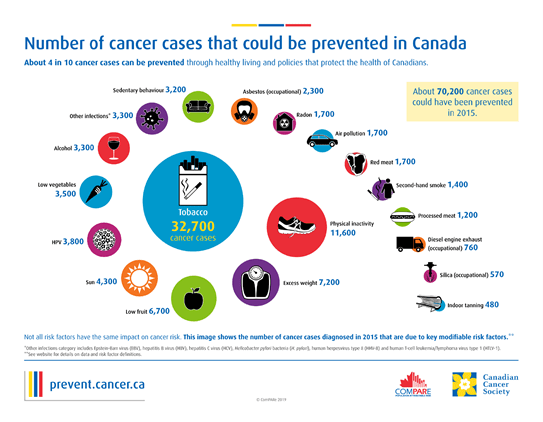The ComPARe study found that about 4 in 10 cancer cases can be prevented through healthy living and policies that protect the health of Canadians. Wondering what factors increase your risk of cancer, and how healthy living and policies help protect you and your family? Here’s a breakdown of why the ComPARe study is so important and how its findings impact you. To view the full results of the study, visit prevent.cancer.ca.
What are the leading causes of preventable cancers?
Currently, the top 5 leading preventable causes of cancer are smoking tobacco, followed by physical inactivity, excess weight, low intake of fruit and sun exposure.
Risk Factors
A cancer risk factor is any substance or condition that increases the risk of developing cancer. Modifiable risk factors are behaviours and exposures that, in theory, can be changed.
The ComPARe study found that about 4 in 10 cancer cases can be prevented, meaning that about 6 in 10 cannot be prevented. Making changes to reduce your cancer risk doesn’t mean that you won’t get cancer – but it does mean that your chance of getting the disease is lower.
Some risk factors that influence a person’s chance of developing cancer but cannot be changed include age, sex, genetics and a family history of cancer. Other risk factors can be modified by lifestyle choices, interventions such as vaccination, and the kind of environment a person lives and works in.

The ComPARe study paints a clear picture of preventable cancer cases in Canada. The findings help us understand where we can change our lifestyles and environments to prevent cancer – and what the future will look like if we do.
More than 200,000 Canadians will hear the words “You have cancer” every year. Knowing more about the most important modifiable risk factors can help us stop cancer before it starts – and reduce the number of future cancer cases.
What are the most preventable and least preventable cancers?
The ComPARe study found that cervical cancers are the most preventable cancers. Virtually 100% of cervical cancer cases can be prevented. Getting the HPV vaccine and being screened regularly for cervical cancer are some of the key ways women can reduce their risk.
Thanks to the ComPARe study, we also know that about 86% of lung cancer cases are preventable. Canadians can reduce their risk of lung cancer by quitting smoking, or never starting, and reducing exposure to harmful substances at work.
The least preventable cancer studied is prostate cancer. Only 4% of advanced prostate cancer cases are preventable based on currently known risk factors. CCS encourages men to speak with their doctor about testing for prostate cancer.
What could the future look like if we act now?
The ComPARe study has shown us where we can make the biggest difference in cancer prevention – but it’s up to us to take action. Individuals can only make choices within the communities in which they live. This is why it is so important to implement healthy public policies to create supportive environments.
For the first time, we now understand how many cancer cases we can prevent if we work together. For example, together:
- We could prevent about 50,200 cancer cases by 2042 if more Canadians quit or didn’t start smoking.
- We could prevent about 26, 200 cancer cases by 2042 if more Canadians were active.
- We could prevent about 110,600 cancer cases by 2042 if more Canadians had a healthy body weight.
CCS is committed to improving and saving lives – preventing cancer is an important part of this commitment. This new study gives us insight into where we can make the biggest difference in cancer prevention for Canadians so they can live their lives to the fullest.
